
Prestongrange Industrial Heritage Museum
Encyclopedia
The Prestongrange Industrial Heritage Museum is an industrial heritage
museum
at Prestongrange
between Musselburgh
and Prestonpans
on the B1348 on the East Lothian
coast, Scotland
UK.
Founded as the original site of the Scottish Mining Museum
, its operation reverted to East Lothian Council Museum Service (the current operators) in 1992. Prestongrange Colliery had closed in 1962 and the site began to be cleared. However, work stopped when a new plan was adopted. The Museum was the idea of David Spence, a retired mining engineer. A steering committee was formed in 1968, volunteers worked to clear the site and assemble exhibits, and the Scottish Mining Museum was formally launched at Prestongrange on 28 September 1984.
 By the early 1960s the strategy of the National Coal Board
By the early 1960s the strategy of the National Coal Board
meant that all of East Lothian’s and most of Midlothian’s collieries were earmarked for closure. At the same time within the coalfield community there was an awareness that technology and culture was also changing and much that was of significance was in danger of being lost forever.
Prestongrange had three key merits as a museum site. The estate features in the earliest written account of collieries in Scotland, often dated to 1180-1210. The existing colliery included the first deep shaft in Scotland, which Matthias Dunn
of Newcastle sank in 1830 to the Great Seam at 420 feet (128 m). The colliery housed the last Cornish beam engine remaining in situ in Scotland.
Artefacts were collected from around the coalfield and stored at Prestongrange. The interior of the beam engine house and the colliery power station became galleries. With the closure of Lady Victoria Colliery at Newtongrange
in 1981 the ambitions of the steering group expanded to include that site. After operating together from 1984 to 1992 Prestongrange was withdrawn from the Scottish Mining Museum by East Lothian District Council and recast as Prestongrange Industrial Heritage Museum to encompass the area’s other once significant but vanished industries – salt boiling
, chemical synthesis
(particularly sulphuric acid
), soap making
, glass making
, potteries
, industrial ceramics and bricks.
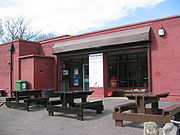
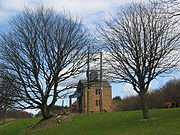
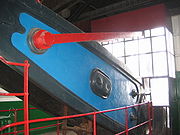
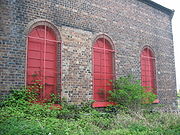
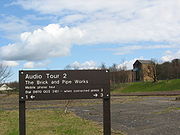
, an early type of steam engine
, used to pump water from the coal mine to prevent the workings from becoming flooded. It was made by Harvey and Company and used in four different mines in Cornwall
before being purchased by the Prestongrange Coal and Iron Company in 1874 and shipped north. The 30-ton engine was installed in a new engine house, whose front wall is nearly 7 feet (2.1 m) thick in order to support the main pivot bearing of the huge cast iron beam.
The engine continued operating until 1954, when it was superseded by electric pumps, only eight years before the colliery closed. The engine is the only example in Scotland.
who was born in Port Seton.
The Museum is also the gateway to the annual Three Harbours Festival, jointly organised by the communities of Prestonpans
, Prestongrange
, Cockenzie, Port Seton and other nearby areas such as West Pans and Drum Mhor.
The Museum grounds are also used for local events, guided tours, theatrical performances, and during the annual re-enactments of the Battle of Prestonpans
. Since the completion of the Prestonpans Tapestry
in July 2010, there is a possibility that this artwork may find a temporary or permanent home at Prestongrange.
Industrial heritage
Industrial heritage is an aspect of cultural heritage dealing specifically with the buildings and artifacts of industry which are inherited from past generations, maintained in the present and bestowed for the benefit of future generations, often forming a significant attraction for tourism.The...
museum
Museum
A museum is an institution that cares for a collection of artifacts and other objects of scientific, artistic, cultural, or historical importance and makes them available for public viewing through exhibits that may be permanent or temporary. Most large museums are located in major cities...
at Prestongrange
Prestongrange
Prestongrange is a place in East Lothian, Scotland, UK, situated between Musselburgh to the west, and Prestonpans in the east.The placename derives from "Preston", meaning "priest's town", and a grange which was worked by the Cistercian monks of Newbattle Abbey.In the 16th century the Morison...
between Musselburgh
Musselburgh
Musselburgh is the largest settlement in East Lothian, Scotland, on the coast of the Firth of Forth, six miles east of Edinburgh city centre.-History:...
and Prestonpans
Prestonpans
Prestonpans is a small town to the east of Edinburgh, Scotland, in the unitary council area of East Lothian. It has a population of 7,153 . It is the site of the 1745 Battle of Prestonpans, and has a history dating back to the 11th century...
on the B1348 on the East Lothian
East Lothian
East Lothian is one of the 32 council areas of Scotland, and a lieutenancy Area. It borders the City of Edinburgh, Scottish Borders and Midlothian. Its administrative centre is Haddington, although its largest town is Musselburgh....
coast, Scotland
Scotland
Scotland is a country that is part of the United Kingdom. Occupying the northern third of the island of Great Britain, it shares a border with England to the south and is bounded by the North Sea to the east, the Atlantic Ocean to the north and west, and the North Channel and Irish Sea to the...
UK.
Founded as the original site of the Scottish Mining Museum
Scottish Mining Museum
The Scottish Mining Museum was created in 1984, to preserve the physical surface remains of Lady Victoria Colliery at Newtongrange, Midlothian, Scotland. The colliery, sunk by the Lothian Coal Company in 1890, came into production in 1894...
, its operation reverted to East Lothian Council Museum Service (the current operators) in 1992. Prestongrange Colliery had closed in 1962 and the site began to be cleared. However, work stopped when a new plan was adopted. The Museum was the idea of David Spence, a retired mining engineer. A steering committee was formed in 1968, volunteers worked to clear the site and assemble exhibits, and the Scottish Mining Museum was formally launched at Prestongrange on 28 September 1984.
Development

National Coal Board
The National Coal Board was the statutory corporation created to run the nationalised coal mining industry in the United Kingdom. Set up under the Coal Industry Nationalisation Act 1946, it took over the mines on "vesting day", 1 January 1947...
meant that all of East Lothian’s and most of Midlothian’s collieries were earmarked for closure. At the same time within the coalfield community there was an awareness that technology and culture was also changing and much that was of significance was in danger of being lost forever.
Prestongrange had three key merits as a museum site. The estate features in the earliest written account of collieries in Scotland, often dated to 1180-1210. The existing colliery included the first deep shaft in Scotland, which Matthias Dunn
Matthias Dunn
Matthias Dunn was an Inspector of Mines in the North-east of England, United Kingdom during the 19th century. He lived at Stella Hall, Newcastle-on-Tyne, and owned a quarter share in the Stargate Pit which was the site of the Stargate Pit Explosion of 1826.In 1830 he sunk a new shaft, the "Great...
of Newcastle sank in 1830 to the Great Seam at 420 feet (128 m). The colliery housed the last Cornish beam engine remaining in situ in Scotland.
Artefacts were collected from around the coalfield and stored at Prestongrange. The interior of the beam engine house and the colliery power station became galleries. With the closure of Lady Victoria Colliery at Newtongrange
Newtongrange
Newtongrange is a former mining village in Midlothian, Scotland. Known in local dialect as Nitten, or Nitten by the Bing ,it became Scotland's largest mining village in the 1890s, with the sinking of the Lady Victoria Colliery and a shaft over 1600 feet deep...
in 1981 the ambitions of the steering group expanded to include that site. After operating together from 1984 to 1992 Prestongrange was withdrawn from the Scottish Mining Museum by East Lothian District Council and recast as Prestongrange Industrial Heritage Museum to encompass the area’s other once significant but vanished industries – salt boiling
History of salt
Salt's ability to preserve food was a foundation of civilization. It eliminated the dependence on the seasonal availability of food and it allowed travel over long distances. However, salt was difficult to obtain, and so it was a highly valued trade item...
, chemical synthesis
Chemical synthesis
In chemistry, chemical synthesis is purposeful execution of chemical reactions to get a product, or several products. This happens by physical and chemical manipulations usually involving one or more reactions...
(particularly sulphuric acid
Sulfuric acid
Sulfuric acid is a strong mineral acid with the molecular formula . Its historical name is oil of vitriol. Pure sulfuric acid is a highly corrosive, colorless, viscous liquid. The salts of sulfuric acid are called sulfates...
), soap making
SOAP
SOAP, originally defined as Simple Object Access Protocol, is a protocol specification for exchanging structured information in the implementation of Web Services in computer networks...
, glass making
Glass
Glass is an amorphous solid material. Glasses are typically brittle and optically transparent.The most familiar type of glass, used for centuries in windows and drinking vessels, is soda-lime glass, composed of about 75% silica plus Na2O, CaO, and several minor additives...
, potteries
Pottery
Pottery is the material from which the potteryware is made, of which major types include earthenware, stoneware and porcelain. The place where such wares are made is also called a pottery . Pottery also refers to the art or craft of the potter or the manufacture of pottery...
, industrial ceramics and bricks.





Main features
- the Hoffmann KilnHoffmann kilnThe Hoffmann kiln is a series of batch process kilns. Hoffmann kilns are the most common kiln used in production of bricks and some other ceramic products...
(or, more precisely, the Hoffmann Continuous Kiln) - the Cornish engineCornish engineA Cornish engine is a type of steam engine developed in Cornwall, England, mainly for pumping water from a mine. It is a form of beam engine that uses steam at a higher pressure than the earlier engines designed by James Watt...
(a type of beam engineBeam engineA beam engine is a type of steam engine where a pivoted overhead beam is used to apply the force from a vertical piston to a vertical connecting rod. This configuration, with the engine directly driving a pump, was first used by Thomas Newcomen around 1705 to remove water from mines in Cornwall...
) the only one in Scotland - the winding engineWinding engineA winding engine is a stationary engine used to control a cable, for example to power a mining hoist at a pit head. Electric hoist controllers have replaced proper winding engines in modern mining, but use electric motors that are also traditionally referred to as winding engines.Most proper...
- the Power House
- the 17th century glass works
- the 18th century potteryPotteryPottery is the material from which the potteryware is made, of which major types include earthenware, stoneware and porcelain. The place where such wares are made is also called a pottery . Pottery also refers to the art or craft of the potter or the manufacture of pottery...
site - the 19th century coal mine and brickBrickA brick is a block of ceramic material used in masonry construction, usually laid using various kinds of mortar. It has been regarded as one of the longest lasting and strongest building materials used throughout history.-History:...
works - Morrison's HavenMorrison's HavenMorrison's Haven is a harbour at Prestongrange, East Lothian, Scotland, UK, on the B1348, close to Levenhall Links, Prestongrange Industrial Heritage Museum, Prestonpans, and Prestongrange House.-History:...
, the 16th century harbour - the railway (remains) and rolling stock
- the Visitor Centre with its exhibition
Beam engine
The beam engine is a Cornish engineCornish engine
A Cornish engine is a type of steam engine developed in Cornwall, England, mainly for pumping water from a mine. It is a form of beam engine that uses steam at a higher pressure than the earlier engines designed by James Watt...
, an early type of steam engine
Steam engine
A steam engine is a heat engine that performs mechanical work using steam as its working fluid.Steam engines are external combustion engines, where the working fluid is separate from the combustion products. Non-combustion heat sources such as solar power, nuclear power or geothermal energy may be...
, used to pump water from the coal mine to prevent the workings from becoming flooded. It was made by Harvey and Company and used in four different mines in Cornwall
Cornwall
Cornwall is a unitary authority and ceremonial county of England, within the United Kingdom. It is bordered to the north and west by the Celtic Sea, to the south by the English Channel, and to the east by the county of Devon, over the River Tamar. Cornwall has a population of , and covers an area of...
before being purchased by the Prestongrange Coal and Iron Company in 1874 and shipped north. The 30-ton engine was installed in a new engine house, whose front wall is nearly 7 feet (2.1 m) thick in order to support the main pivot bearing of the huge cast iron beam.
The engine continued operating until 1954, when it was superseded by electric pumps, only eight years before the colliery closed. The engine is the only example in Scotland.
Facilities
The Museum site is open all day every day. The Museum buildings are open between April and October, 11.30 a.m. to 4.30pm. A self-guided tour by mobile phone is available, and it is narrated by the painter John BellanyJohn Bellany
John Bellany, CBE, RA is a Scottish painter.He was born in Port Seton. During the 1960s, he studied at Edinburgh College of Art and then at the Royal College of Art in London....
who was born in Port Seton.
The Museum is also the gateway to the annual Three Harbours Festival, jointly organised by the communities of Prestonpans
Prestonpans
Prestonpans is a small town to the east of Edinburgh, Scotland, in the unitary council area of East Lothian. It has a population of 7,153 . It is the site of the 1745 Battle of Prestonpans, and has a history dating back to the 11th century...
, Prestongrange
Prestongrange
Prestongrange is a place in East Lothian, Scotland, UK, situated between Musselburgh to the west, and Prestonpans in the east.The placename derives from "Preston", meaning "priest's town", and a grange which was worked by the Cistercian monks of Newbattle Abbey.In the 16th century the Morison...
, Cockenzie, Port Seton and other nearby areas such as West Pans and Drum Mhor.
The Museum grounds are also used for local events, guided tours, theatrical performances, and during the annual re-enactments of the Battle of Prestonpans
Battle of Prestonpans
The Battle of Prestonpans was the first significant conflict in the Jacobite Rising of 1745. The battle took place at 4 am on 21 September 1745. The Jacobite army loyal to James Francis Edward Stuart and led by his son Charles Edward Stuart defeated the government army loyal to the Hanoverian...
. Since the completion of the Prestonpans Tapestry
Prestonpans Tapestry
The Prestonpans Tapestry is a large embroidery created - and normally situated in - Prestonpans, East Lothian, Scotland.Its full title is "The Battle of Prestonpans Tapestry 1754"....
in July 2010, there is a possibility that this artwork may find a temporary or permanent home at Prestongrange.
See also
- Manual labourManual labourManual labour , manual or manual work is physical work done by people, most especially in contrast to that done by machines, and also to that done by working animals...
- Wage labourWage labourWage labour is the socioeconomic relationship between a worker and an employer, where the worker sells their labour under a formal or informal employment contract. These transactions usually occur in a labour market where wages are market determined...
- Industrial archaeologyIndustrial archaeologyIndustrial archaeology, like other branches of archaeology, is the study of material culture from the past, but with a focus on industry. Strictly speaking, industrial archaeology includes sites from the earliest times to the most recent...
- List of industrial archaeology topics
- European Route of Industrial HeritageEuropean Route of Industrial HeritageThe European Route of Industrial Heritage is a network of the most important industrial heritage sites in Europe. The aim of the project is to create interest for the common European Heritage of the Industrialisation and its remains...
(ERIH) - List of places in East Lothian
- Scottish Industrial Heritage Society (SIHS)
External links
- The Museum's website
- Prestongrange Community Archaeological Project
- Self-guided tour leaflet
- BBC page on beam engines, including an animation
- National Trust website on Levant Beam Engine
- East Lothian Museums 'Behind the Scenes' – photos taken at Prestongrange
- SCRAN database, part of RCAHMS (Royal Commission on the Ancient and Historical Monuments of Scotland)

